Stretching at home is a simple yet powerful way to restore mobility, improve posture, and energize daily routines.
Flexibility is essential for healthy living, as it reduces injury risk, eases everyday tasks, improves circulation, supports balance, and relieves stress.
Even a few minutes of stretching daily can shift how your body feels and performs. Stretching is gentle yet effective, suitable for all ages and fitness levels, and can be done in the comfort of your living room with a floor mat.
Harvard Health emphasizes regular stretching for muscle flexibility and joint range of motion, recommending daily or multiple times a week, focusing on key areas, warming up before, and avoiding bouncing during stretches.
This guide provides stretching routines to improve flexibility, unlock hidden strength, and provide comfort to help reclaim freedom of movement and maintain vitality.

Why Flexibility Matters More Than You Think
Flexibility is crucial for health, as stretching at home improves body movement, restores energy, and protects against setbacks. It addresses daily problems, offers simple solutions, and can be applied to daily life.
The Surprising Link Between Flexibility and Daily Movement
Flexibility is crucial in daily activities like bending, twisting, and reaching, as it prevents discomfort and stiffness, leading to increased body tightness over time.
Consistent stretching can help loosen tight muscles and joints, regaining freedom in everyday movements, making sitting at the desk less cramped and climbing stairs easier.
After two weeks of daily stretching, I felt my body move more easily, proving that small, steady efforts improve mobility over time.
How Stretching Improves Posture, Balance, and Energy
Poor posture, often caused by prolonged sitting, can drain energy, appear older, and cause balance issues due to tight muscles.
Stretching enhances posture, stability, and blood flow, promoting a more alert and energized body.
I feel taller, breathe deeper, and carry confidence after adding daily targeted stretches—stretch straps make each move count.
Flexibility as a Key to Preventing Injuries
Injuries occur when the body resists sudden changes, leading to strains, sprains, or long-term joint problems due to tight muscles resisting sudden changes.
Stretching prepares muscles and joints for unexpected movement, creating a safety buffer and tuning up the body for daily life demands.
Harvard Health emphasizes the importance of flexibility in long-term wellness, stating that regular stretching improves joint mobility, reduces muscle stiffness, and supports balance, preventing falls and promoting independence.
I stretch every night, and my back pain has dropped. I feel stronger, more resilient, and I am taking charge of my health instead of just reacting to problems.
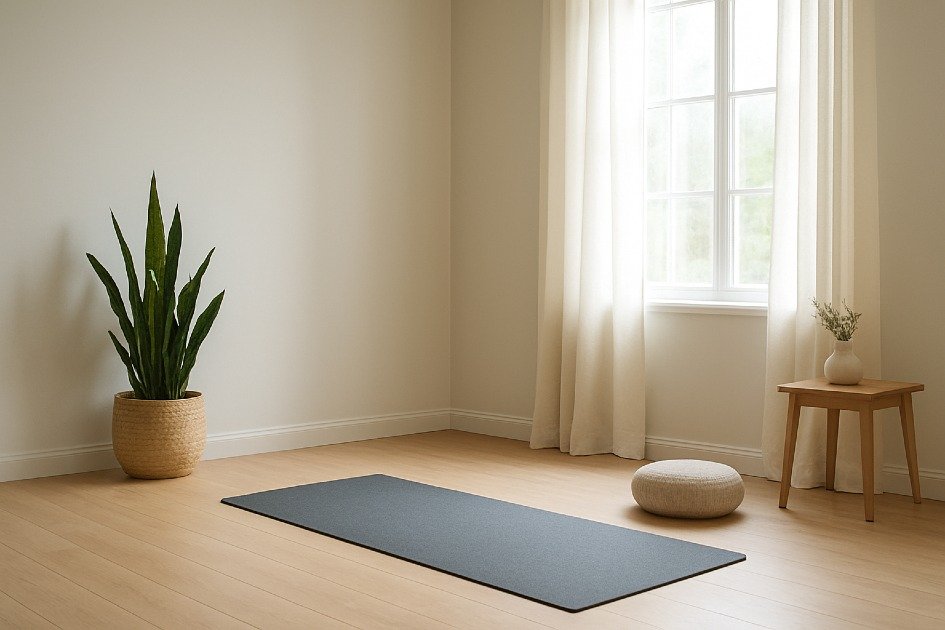
Creating the Perfect Stretching Environment at Home
A successful stretching routine is not just about the movements; it also involves creating a comfortable, enjoyable, and consistent environment for practice.
Choosing a Safe, Comfortable Space
Many people skip stretching at home due to cramped or cluttered spaces. To avoid discomfort and missed benefits, create a small, free-moving area with a 6-by-6-foot space.
Creating a dedicated stretching zone can motivate and make stretching a habit, turning it into a routine.
Must-Have Items: Yoga Mat, Towel, or Cushion
Stretching on hard floors can cause discomfort, especially for knees, wrists, and lower back.
A supportive yoga mat is recommended for long stretches, while a folded towel or firm cushion can provide temporary support.
Using my yoga mat improved my stretching, letting me focus on proper form without hurting my knees.
How to Set a Calming Atmosphere
Stretching is not only physical but also mental. To relax, create a calm environment with natural sunlight, soft music, and calming scents. Avoid distractions like loud noises, clutter, and harsh lighting, and focus on your body.
Soft lighting and gentle music turned my stretching into a relaxing self-care ritual, helping me slow down and tune into my body.
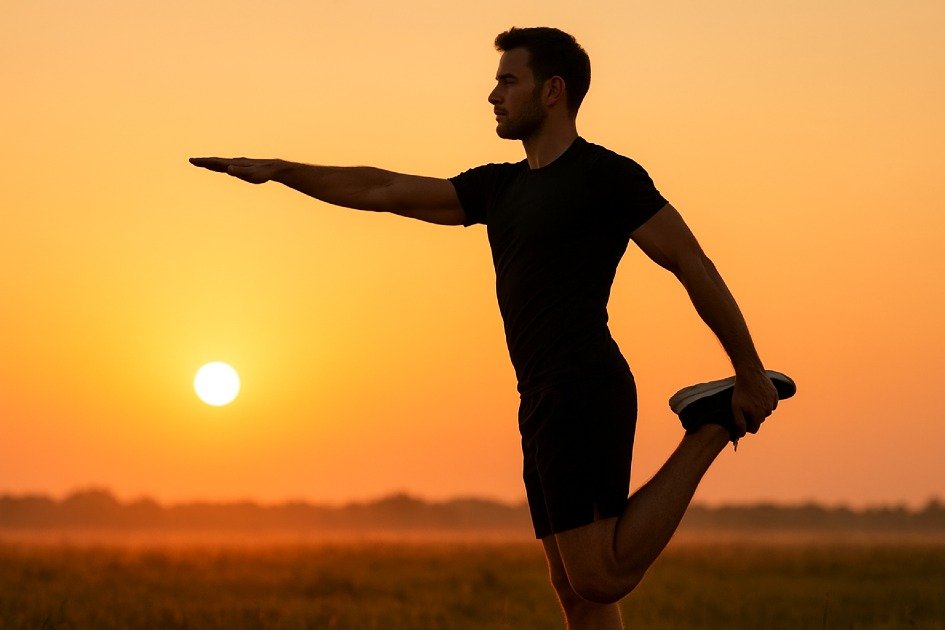
Best Time of Day to Stretch for Maximum Results
Choosing the right time for stretching can significantly impact your body’s performance and flexibility, affecting your overall health and lifestyle, and should be tailored to your specific needs.
Morning Stretches to Wake Up Your Body
Lack of morning stretch can lead to stiffness, sluggish energy, and poor posture throughout the day, as the body signals for movement.
Gentle, dynamic stretches like shoulder rolls, cat-cow stretches, or standing side bends can help wake up circulation and loosen spine tension, taking only five to ten minutes.
I start my day with a quick stretch before coffee. Using a light yoga mat makes it easy and boosts my energy fast.
Evening Routines to Release Tension
Nighttime muscle strain from desk work, long commutes, and chores can cause tight hips, stiff lower back, and sore shoulders, leading to tension and sleep disturbance.
Harvard Health suggests stretching before bedtime to stimulate the body, improve circulation, and activate the parasympathetic system, promoting a relaxed state and a calmer start to the day.
An evening stretching ritual, including static stretches like forward folds, hip openers, and spinal twists, helps reset the nervous system, lengthen muscles, and prepare for deeper rest.
I stretch for 10 minutes before bed to relax my body and calm my mind—way better than scrolling on my phone. I like to add soft music or a guided relaxation app to make it even more soothing.
How to Match Stretching with Your Lifestyle
There is no “perfect” time for stretching; it depends on your body’s response. Rushing mornings may cause stress, while slow mornings set the right tone. Evaluate various times and adjust schedules to suit your needs.
I stretch a little after brushing my teeth in the morning and again at night. Doing this daily keeps me flexible and makes stretching a habit I stick with.
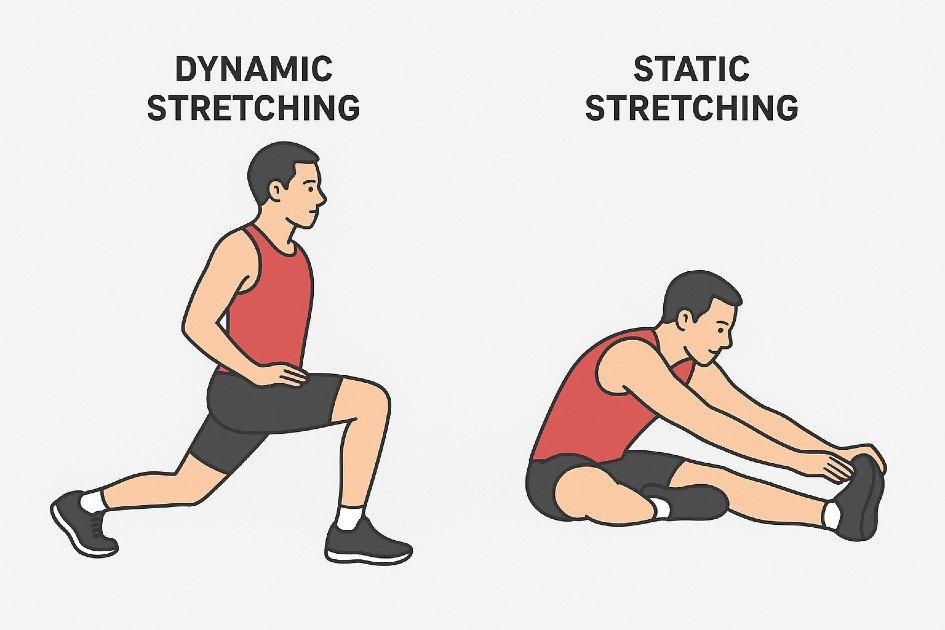
Dynamic vs. Static Stretching: Know the Difference
Dynamic and static stretching are essential for enhancing flexibility and preventing injuries, with each offering unique benefits and practicality.
What Dynamic Stretching Does for Warm-Ups
Dynamic stretching involves gentle, controlled motions like leg swings, arm circles, or walking lunges to prepare muscles for exercise, preventing stiffness and injury.
I boosted my running by adding dynamic stretches, which gave me a smoother stride and less cramping, making runs more enjoyable.
Why Static Stretches Help with Relaxation
Static stretching involves holding a position for 15-20 seconds to lengthen muscles, calm the nervous system, and ease tension.
It helps release tension and clears mental stress, making it an effective antidote to tight, tense muscles from prolonged sitting.
I like using a thick yoga mat for my evening stretches. It cushions my body and makes holding poses much easier and more comfortable.
When to Use Each Type for Best Results
Balance between dynamic and static stretching is crucial for optimal performance.
Beginners often struggle with mixing up stretches, as static stretches can reduce strength and speed. Dynamic movements wake up the body, followed by static stretches for calmness.
I make stretching part of my day. Just 5 minutes before and after moving keeps my body flexible, helps me recover faster, and gives me better control.

Upper Body Stretches You Can Do Anywhere
Daily stretching can relieve tension, improve posture, and boost circulation in the upper body, especially during long work hours and phone usage.
Neck Release: Relieve Tension and Boost Focus
Why it matters:
Screen time can cause neck stiffness and headaches. Stretching neck improves blood flow, reduces fatigue, and prevents long-term postural issues.
How to do it:
- Keep your back straight and stand tall.
- Tilt your head to the right shoulder and hold for 15–20 seconds.
- Tilt your chin down, then roll it to the left.
- Do it 2–3 times per side.
I keep my shoulders loose and take slow, deep breaths to feel the full stretch.
Shoulder Shrugs and Rolls: Open Tight Shoulders
Why it matters:
Tight shoulders can cause upper back pain and limit mobility. Releasing shoulder tension aids in lifting, carrying, and overhead movements, while stretching enhances range of motion for daily activities.
How to do it:
- Lift your shoulders to your ears and pause for 3 seconds.
- Roll your shoulders in small circles, first back, then forward.
- Do ten reps each way.
- Use resistance bands to build strength and improve flexibility.
Chest Opener: Combat Rounded Posture
Why it matters:
Hunched shoulders from desk work or phone usage restrict breathing and circulation. Opening the chest improves posture, relieves mid-back tension, and enhances shoulder mobility for reaching and lifting.
How to do it:
- Stand in a doorway and rest your forearms against the sides.
- Step forward slowly until your chest feels a stretch.
- Hold the stretch 20–30 seconds and breathe slowly.
- Do it two times a day.
I keep my head neutral, so I do not strain my neck. When I look straight ahead instead of tilting up or down, my posture feels stronger, and my workouts stay safe.
Arm Across Chest Stretch: Reduce Shoulder Soreness
Why it matters:
Overuse of arms and shoulders can cause stiffness and minor injuries, while stretching across the chest helps maintain flexibility and reduces muscle tightness.
How to do it:
- Stretch your right arm across your chest.
- Gently pull it closer with your left hand.
- Hold 15–20 seconds, then switch sides.
- Do 2–3 sets for each arm.
- Do this stretch after sitting or workouts to stay flexible.
Wrist and Forearm Stretch: Support Your Daily Tasks
Why it matters:
Typing, texting, and gripping can strain wrists and forearms, but stretching can prevent repetitive strain injuries and enhance hand function.
How to do it:
- Stretch one arm forward with your palm facing up.
- With your other hand, gently pull your fingers down to stretch the forearm.
- Hold for 15 seconds, then switch sides.
- Rotate your wrists in gentle circles to ease tension.
I do wrist and forearm stretches every day to ease the strain from typing and scrolling.
Upper Back Stretch: Release Tension Between Shoulder Blades
Why it matters:
Stiffness in the upper back can lead to discomfort, poor posture, and headaches, but stretching this area can enhance mobility and support shoulder function.
How to do it:
- Clasp your hands and stretch your arms straight in front at shoulder level.
- Stretch your arms forward and curve your upper back.
- Hold 15–30 seconds, repeat two times.
- Move slowly and with control to fully work your muscles.
How to Make Upper Body Stretching a Habit
- Use short breaks at work or home to stretch and refresh your body.
- Stretch while taking deep breaths to boost results.
- Set reminders or using apps to stay consistent.
- Monitor your progress to watch your flexibility grow.
I use a quality resistance band and yoga mat for quick at-home stretches. In just five minutes, I release tension, improve my posture, and boost my upper body mobility.

Lower Body Stretches That Unlock Mobility
Improving lower body flexibility can enhance daily movement, prevent injuries, and relieve chronic stiffness.
Focusing stretches on tight hips, hamstrings, and calves can improve energy, posture, and physical performance.
Hip Openers: Release Stiffness and Improve Range of Motion
Why this matters:
Tight hips can cause back pain, poor posture, and limited mobility. Opening them improves blood flow, reduces tension, and prepares the lower body for all movements.
How to do it:
- Butterfly Stretch: Sit on the floor, put your feet together, and let your knees drop outward. Press your knees gently toward the floor with your elbows.
- Pigeon Pose: Begin in a plank. Bring your right knee toward your left wrist. Stretch your left leg back, keeping hips level. Hold 20–30 seconds, then switch sides.
- Lunge with Twist: Step your right foot forward into a deep lunge. Twist your torso to the right and lift your left arm up. Hold, breathe, then switch sides.
I move my hips gently and never force them; small, steady pressure brings the best results.
Hamstring Stretches: Relieve Tightness and Boost Flexibility
Why this matters:
Tight hamstrings cause pain and stiffness in the lower back, while flexible hamstrings enhance stride, reduce injury risk, and enhance comfort.
How to do it:
- Seated Forward Fold: Sit with legs straight. Lean forward from your hips, reaching your hands toward your toes, keeping your back straight.
- Standing Hamstring Stretch: Step your right foot onto a low bench. Keep your leg straight and lean forward from your hips. Hold 20–30 seconds, then switch sides.
- Lying Hamstring Stretch: Lie on your back and lift your right leg. Loop a strap or towel around your foot and hold it. Keep your left leg on the floor. Switch legs.
I stretch slowly, feeling my muscles lengthen. I breathe deeply to let tension go naturally.
Calf and Ankle Stretches: Support Balance and Stability
Why this matters:
Tight calves can hinder ankle mobility, impacting walking, running, and standing balance. Stretching calves can prevent cramps, Achilles tendon pain, and lower leg fatigue.
How to do it:
- Wall Calf Stretch: Face a wall and place your hands on it. Step one foot back, press the heel down, hold, then switch legs.
- Downward Dog Pose: Start in a plank. Lift your hips up, press your heels down, and stretch your calves while keeping your core tight.
- Ankle Circles: Sit or stand, rotate each ankle slowly in both directions to boost flexibility and joint mobility.
I move my body a little each day instead of forcing deep stretches. Just 30 seconds per leg helps me get more flexible over time.
Flow Routine: Combine Lower Body Stretches for Maximum Effect
Why this matters:
Combining stretches in a short flow routine boosts circulation, enhances functional flexibility, and enhances enjoyment. Consecutive stretches prepare the lower body for movement and prevent stiffness.
How to do it:
- Begin with hip openers with a butterfly and twisting lunge
- Next stretch your hamstrings with a seated forward fold or lying hamstring stretch
- End with calf and ankle stretches with a wall push and circles
- Do the flow 2–3 times, breathe deeply, and release tension slowly.
I track my progress in a notebook, use a stretching strap or yoga mat, and spend 10–15 minutes daily on lower body stretches to stay flexible, ease stiffness, and move better.
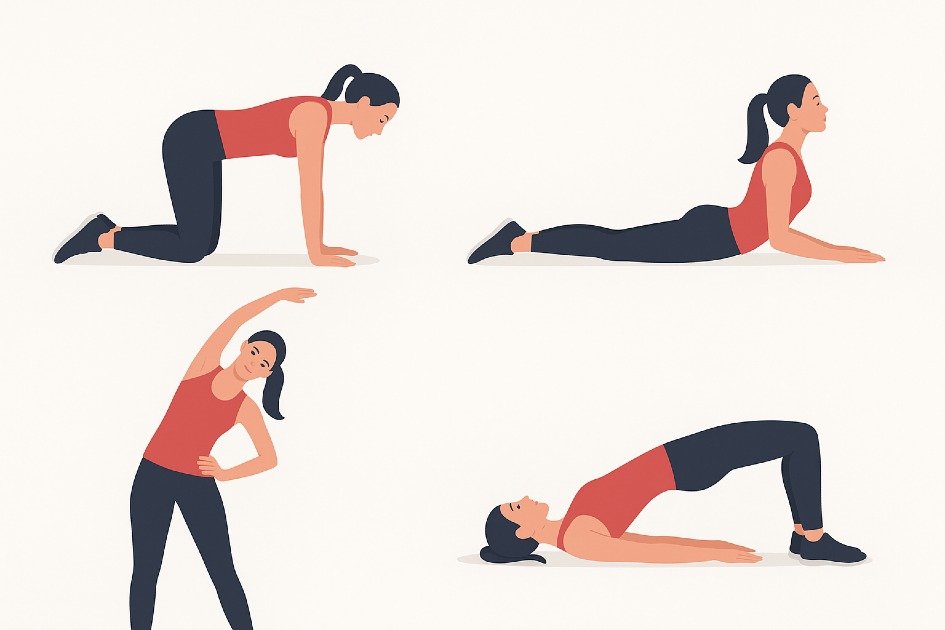
Core and Back Stretches for Strength and Flexibility
Core and back weaknesses can lead to poor posture, back pain, and decreased mobility. Targeted stretching routines relieve tension and strengthen the body from the inside out.
Gentle Twists to Release Spinal Tension
Why this matters:
Long-term sitting compresses the spine, reducing mobility. Twisting stretches improve spinal rotation, reduce stiffness, promote posture, and stimulate blood flow, easing chronic back discomfort.
How to do it:
- Sit down and stretch your legs straight out in front of you.
- Cross your right knee over the left and place your foot flat on the floor.
- Twist your torso right and rest your left elbow on the outside of your right knee.
- Stay in position 20–30 seconds, breathing slowly and deeply.
- Flip sides and do it again.
I slowly twist a little more each time; with regular practice, my flexibility grows.
Lower Back Stretches for All-Day Relief
Why this matters:
Prolonged sitting or standing can cause discomfort in tight lower back muscles, but stretching can enhance range of motion and prevent future injuries.
How to do it:
- Lie on your back, bend your knees, and place your feet flat on the floor.
- Pull your knees gently to your chest.
- Gently sway side to side to ease tension in your lower spine.
- Hold 30–40 seconds, letting your muscles fully relax.
I often feel relief after just one set, so I like adding this to my morning or evening routine.
Abdominal Stretches to Counter Slouching
Why this matters:
Tight abdominal muscles can cause poor posture and back pain by pulling the spine forward, while stretching the core strengthens the connection between front and back muscles.
How to do it:
- Stretch out on your stomach on a yoga mat.
- Position your palms directly beneath your shoulders for proper support.
- Press your hands down to lift your chest while keeping your hips on the floor.
- Breathe in deeply and hold for 15–20 seconds.
- Lower yourself slowly and repeat 3–5 times.
I stretch regularly to stay flexible and move with better posture, whether at my desk or lifting things.
Bridge Pose for Spinal and Core Activation
Why this matters:
The bridge pose is a stretching technique that strengthens the glutes, lower back, and core, improves flexibility, and combats the effects of prolonged sitting.
How to do it:
- Lie on your back, bend your knees, and keep your feet hip-width apart.
- Push your feet down and raise your hips up.
- Relax your shoulders and let your head rest lightly on the mat.
- Hold for 20–30 seconds, then slowly lower.
- Do 3–4 rounds.
I stretch to work many muscles at once, building real strength and staying flexible.
Cat-Cow Flow to Mobilize the Spine
Why this matters:
The Cat-Cow flow improves spinal flexibility by activating core and back muscles, reducing stiffness and increasing injury risk in the spine designed for multiple directions.
How to do it:
- Begin on your hands and knees, keeping your back flat like a table.
- Breathe in, lower your belly, and lift your head and tailbone into Cow Pose.
- Breathe out, arch your back, and tuck your chin toward your chest in Cat Pose.
- Flow through 10–15 rounds, synchronizing each move with your breath.
I start my mornings by stretching to wake up my spine and shake off overnight tension.
Easy Steps for Core and Back Stretching
- Take deep breaths to fuel your muscles with more oxygen.
- Stretching gently mild tension is okay, sharp pain is not.
- Pair these moves with gentle upper- and lower-body stretches for full-body flexibility.
- Track your flexibility regularly tiny daily gains add up to big results.
I add core and back stretches to my daily routine to boost my posture, ease tension, and stay flexible using a yoga mat or props makes it even better.
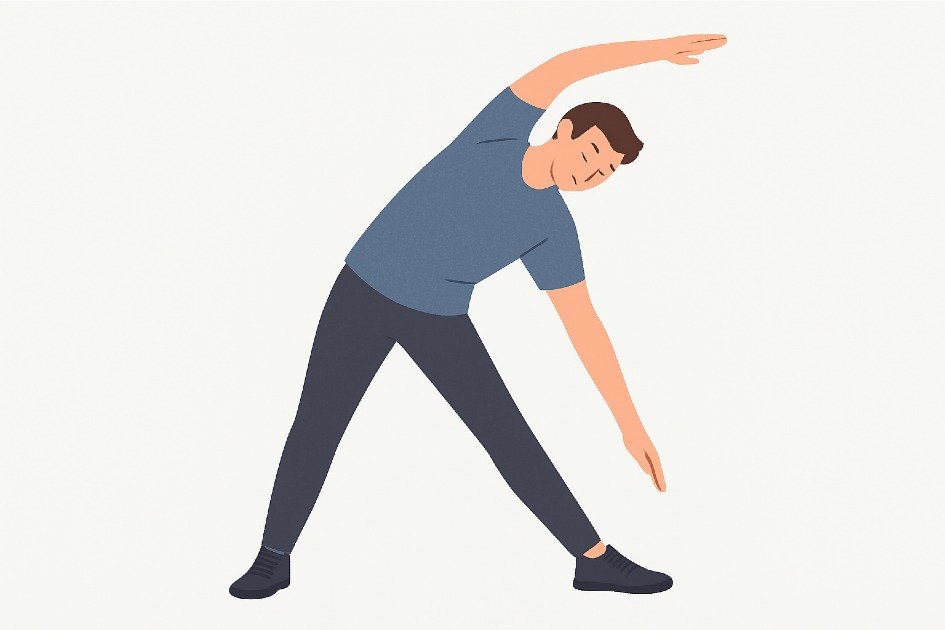
Full-Body Routines for Deep Flexibility
Stretching your entire body improves mobility, reduces aches, enhances posture, and boosts energy levels, requiring practical, achievable steps to unlock natural range of motion.
Flow-Style Stretches for Total-Body Mobility
Why it matters:
Flow-style stretching involves multiple movements to warm up major muscle groups, promote circulatory health, release lactic acid, improve blood flow, coordinate muscles for smoother movements, and prevent stiffness.
How to do it:
- Stand tall with your feet hip-width apart, ready to move.
- Breathe in and lift your arms up; breathe out and bend forward, reaching for your toes.
- Slowly lift your spine one vertebra at a time, then reach gently to the side.
- Flow from a cat-cow stretch on the floor into a low lunge, switching sides smoothly
- Finish with arm circles and gentle twists, holding each 15–20 seconds.
- Do this flow 5–10 minutes each day.
I breathe in to stretch longer, breathe out to go deeper.
Combining Upper and Lower Body Stretches Seamlessly
Why it matters:
Many people neglect the synergy of a full routine when stretching upper and lower body separately, leading to functional mobility issues and reduced risk of compensatory injuries.
How to do it:
- Stand tall, bend forward, and reach for your toes to stretch your hamstrings
- Lift your torso, raise your arms, step into a lunge, and twist your torso, engaging hips and spine.
- Clasp your hands behind your back and sink deeper into the lunge to open your shoulders.
- End with a seated side stretch: reach one arm up while keeping the opposite hip ground.
- Do the sequence 2–3 times, switching sides for even flexibility.
I move slowly, holding each stretch until I feel a gentle pull, never pain.
Short 10-Minute Routine You Can Do Daily
Why it matters:
Consistency is key for flexibility gains, as a daily routine helps remember correct movement patterns and encourages habit formation, making stretching a natural part of your lifestyle.
How to do it:
- Minute 1–2: Roll your neck and shrug your shoulders to ease tension and improve posture.
- Minute 3–4: Stretch your spine and sides with forward folds and side stretches.
- Minute 5–6: Step into a low lunge, then lift your arms overhead.
- Minute 7–8: Sit tall, extend one leg, reach your toes to stretch your hamstrings, flex your foot to stretch your calf.
- Minute 9–10: Use supine twists and gentle spinal rolls to realign your spine and improve posture.
I use a stretching timer app to track my sessions. Just 10 minutes a day adds up and improves my flexibility fast.
Integrating Props for Deeper Stretches
Why it matters:
Props like straps, blocks, or resistance bands enhance range of motion, help beginners achieve proper alignment, and improve muscle elongation, particularly in tight areas like hips and shoulders.
How to do it:
- Hook a yoga strap around your foot and gently stretch your hamstring while seated.
- Place a block under your hands in forward folds to ease tension and stretch safely.
- Use a resistance band during chest openers to stretch deeper.
- Hold each stretch with a prop for 20–30 seconds and breathe slowly.
I use a stretching band set to add variety and make my home workouts more effective.
Creating a Personalized Full-Body Stretching Flow
Why it matters:
Personalization of routines addresses unique tight areas and daily activities, promotes long-term adherence through manageability and rewarding experiences, and builds awareness of body mechanics to reduce over-stretching risk.
How to do it:
- Do a quick mobility test to spot tight spots in your hips, shoulders, and spine.
- Focus on tight areas first, then move into full body stretches.
- Do both: use dynamic stretches to boost mobility and static stretches to relax muscles.
- Finish with 1–2 minutes of mindful breathing to lock in your flexibility gains.
I track my flexibility in a journal or app. It keeps me motivated and helps me see small improvements over time.
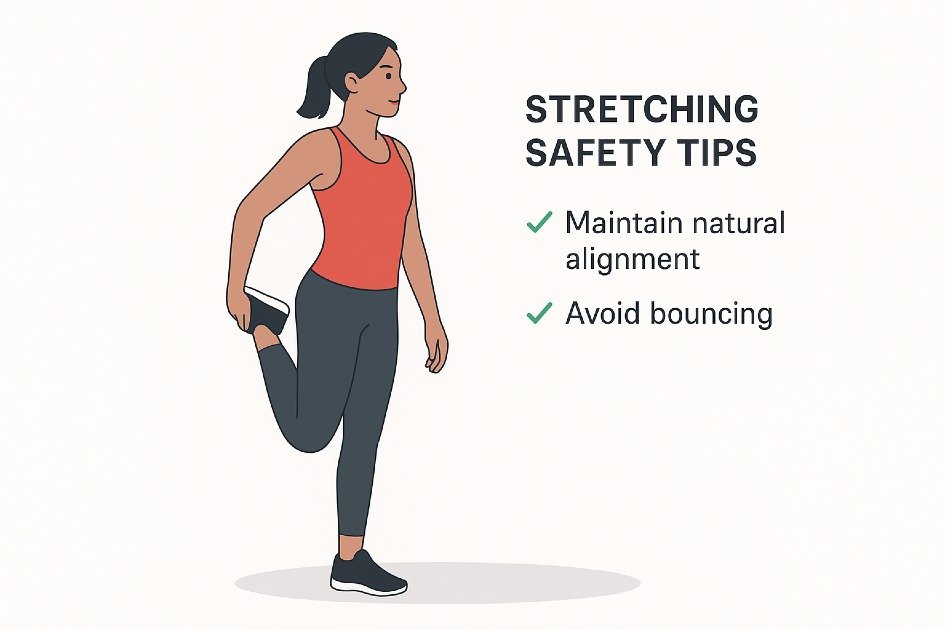
Stretching Safety: Avoid These Common Mistakes
Stretching is crucial for flexibility and well-being, but improper execution can lead to injuries, straining muscles, joints, or connective tissues, despite the misconception that it is risk-free.
Bouncing During Stretches
Why it matters:
Ballistic stretching, a form of intense stretching, can cause muscle damage, overstretch ligaments, and slow progress, leading to soreness over time.
How to do it:
- Ease into each stretch with control.
- Stay in the position for 20–40 seconds.
- Feel the stretch in your muscle, not sharp pain.
- Breathe in and picture your muscles stretching longer.
When I stretch, I go slow. It feels like soft clay in my hands—if I push too hard, it breaks. My body works the same way.
Ignoring Proper Breathing
Why it matters:
Holding your breath during stretches can cause tension, limit flexibility, and increase stress, while oxygen fuels muscles, allowing them to relax and elongate safely.
How to do it:
- Breathe in deeply before you stretch.
- Breathe out as you move into the stretch.
- Breathe in as you get ready, breathe out to stretch further.
- Breathe slowly and count each breath to stay calm and steady.
I stretched while matching my breath, and my hips became flexible in just weeks.
Stretching Cold Muscles
Why it matters:
Cold muscles are stiff and more susceptible to injury, making stretching without warming up like bending a frozen rubber band.
How to do it:
- Warm up for 3–5 minutes by walking, marching, or light jogging.
- Start with dynamic stretches like arm circles and leg swings.
- Warm up your muscles first, then do deep static stretches.
Overstretching to “Feel the Burn”
Why it matters:
Overstretching can cause pain, strain muscles and joints, and hinder flexibility, as it triggers protective tension and setbacks rather than progress.
How to do it:
- Stretch until you feel gentle tension, never pain.
- Use yoga blocks or straps to make poses easier and protect your muscles.
- Improve step by step—steady progress beats rushing.
- Pay attention to your body and stop if it hurts.
I use a resistance strap to stretch safely and reach further without strain.
Neglecting Posture During Stretching
Why it matters:
Proper posture ensures proper muscle targeting and joint safety, as incorrect slouching or twisting can lead to misalignment or nerve pinching.
How to do it:
- Relax your shoulders and lift your chest while stretching your upper body.
- Gently tighten your core to keep your spine steady.
- Bend your knees slightly during hamstring stretches to guard your lower back.
- Check your form in a mirror or by recording yourself.
Skipping Recovery Between Sessions
Why it matters:
Stretching causes micro-tears in muscle fibers, while rest prevents muscle tightening or irritation, reducing flexibility and increasing soreness.
How to do it:
- Rest the same muscles for 24 hours before intense stretching again.
- Do light activity on rest days—walk, bike, or use a foam roller to recover.
- Drink enough water to help your body repair muscles and tissues faster.
- Log your workouts to avoid overtraining and boost recovery.
Rushing Through Your Routine
Why it matters:
Speed in stretching can hinder muscle elongation and miss subtle tension cues, compromising control and causing missed limits.
How to do it:
- Spend 15–20 minutes on each session.
- Stretch with purpose, holding each position until you feel gentle release.
- Take slow breaths and short pauses to help your muscles relax deeply.
- Stretch with focus, not just to finish a list.
I stretch carefully, respecting my body and improving flexibility slowly. I avoid bouncing, overreaching, bad posture, and rushing. Using a yoga mat protects my joints at home.
Recap: Stretch Your Way to a Stronger Body and Mind
Consistent stretching can transform your body, unlocking its full potential, improving circulation, and reducing tension. It enhances flexibility, posture, and vitality.
Stretching is a self-care gift that promotes mindfulness, reduces stress, and strengthens confidence and resilience.
To enhance daily mobility, consider using tools like yoga mats, resistance bands, or foam rollers. Flexibility is a lifestyle, not a luxury.
Start your journey towards a more flexible, vibrant body by making daily stretching an intentional habit. Share your experiences and inspire others to embrace stretching as a lifelong habit.
Frequently Asked Questions
How long should I hold each stretch for optimal flexibility?
Hold static stretches for 20-45 seconds, allowing muscle fibers to elongate gradually. Avoid rushing, and use progressive tools like foam rollers or resistance bands for deeper flexibility.
Can stretching replace a full workout?
Stretching complements physical activity but does not replace cardiovascular or strength exercises. Combining dynamic stretching with light aerobic movements can create an efficient mini workout, especially for home fitness enthusiasts with limited time.
How often should I stretch to see tangible results?
Regular stretching, even short sessions, can improve flexibility, joint mobility, and posture. Start slowly and gradually increase intensity, using tools like yoga mats or stretch-enhancing straps.
Is stretching safe for beginners or older adults?
Stretching is adaptable for all age groups, with gentle static movements and ergonomic stretch bands for proper form and reduced injury risk.
What is the fastest way to improve flexibility at home?
Consistent stretching, proper technique, and recovery are key for muscle pliability, with tools like massage balls or stretch straps for safe deepening.
Can stretching reduce chronic pain or stiffness?
Targeted stretching routines can reduce muscular tension, improve joint mobility, and reduce stiffness from prolonged sitting or repetitive activities, with lumbar support cushions and guided flexibility apps also beneficial.
Should I warm up before stretching?
Warm-up before stretching to improve flexibility. Do light cardio before stretches and use heart rate monitors for optimal warm-up intensity and flexibility improvement.
How does stretching affect mental wellbeing?
Stretching promotes relaxation, reduces cortisol levels, and enhances parasympathetic nervous system activity, promoting mental clarity. Combining guided meditation with stretching routines can further enhance benefits.
Can stretching help with athletic performance?
Consistent stretching, including resistance bands or stretching blocks, can enhance flexibility, improve range of motion, reduce injury risk, and improve muscular coordination, directly benefiting athletic performance.
How do I track progress in flexibility?
Regular tracking of progress, such as measuring reach, hip or shoulder mobility, and using fitness journals or stretch apps, helps maintain motivation and optimize workout routines.

